FY2020 Annual Report
Marine Biophysics Unit
Associate Professor Satoshi Mitarai

Abstract
The Marine Biophysics Unit is at its core, cross-disciplinary. The unit includes researchers of biochemistry, hydrodynamics as well as biologists that study everything from the micro-organism to biogeographic scale. All of this research is connected through Professor Mitarai and his understanding of physical oceanography that is fundamental to all of the unit’s research.
The Marine Biophysics Unit was established at OIST in 2009, making Okinawa its home because of its ideal geographic position and access to research resources. Okinawa is adjacent to the ‘Kuroshio’ current, which is responsible for the diverse marine species that can be found in this region. For better or worse we are also in the center of ‘Typhon Alley’, making Okinawa and OIST the perfect place to study the unique biophysical phenomena that occur in the turquoise waters around us.
Okinawa is home to many rare marine species that live in unique ecosystems such as coral reefs, mangrove forests and deep-sea hydrothermal vents. These ecosystems and the creatures that inhabit them are often separated by hundreds of kilometers of open ocean. In the Marine Biophysics unit (MBU) we study how the physics of ocean currents and the biology of these species allows them to travel as juveniles across the open ocean.
Interactions between biology and physical oceanography not only occur at the large scale of connectivity but also at the scale of individual animals and bacteria. MBU’s other focus is to study how species like coral garden eels and plankton interact with the environment, including the effects of environmental factors on these creatures and vice versa. For example, the surface of marine bacteria may affect their nutrient acquisition in seawater, while environmental parameters may also affect their surface structures and conditions.
Another interaction we study is how the ocean interacts with human activities. For example, human land use on Okinawa island results in the washing of soil into the coastal coral lagoons, a process known locally as ‘red-soil runoff’. The biological response to this red soil in the ocean is complex and may have implications for human health. By understanding the processes of ‘connectivity’ and ‘bio-physical interactions’, we can protect them from human-induced changes that could otherwise lead to the collapse of vulnerable ecosystems in Okinawa or even the loss of rare species from the entire world.
1. Staff
- Dr. Satoshi Mitarai, PI
- Dr. Yuichi Nakajima, Researcher
- Dr. Marine Le Gal, Researcher
- Dr. Angela Ares Pita, Researcher
- Dr. Heng Wu, Researcher
- Dr. Yosuke Yamada, Researcher
- Dr. Margaret Mars Brisbin, Graduate Student
- Maki Thomas, Graduate Student
- Po-Shun Chuang, Graduate Student
- Otis Brunner, Graduate Student
- Kota Ishikawa, Graduate Student
- Kazumi Inoha, Technical Staff
- Akinori Murata, Technical Staff
- Tomoko Yoshino, Research Unit Administrator
- Billy Moore, Rotation Student
- Ayse Oshima, Rotation Student
2. Collaborations
2.1 Collaborative Research (Completed)
- N. Takeda, M. Kashima, S. Odani, Y. Uchiyama, Y. Kamidaira, S. Mitarai, Identification of coral spawn source areas around Sekisei Lagoon for recovery and poleward habitat migration by using a particle-tracking model. Sci. Rep. 11, 6963 (2021).
- L. A. Levin, C.-L. Wei, D. C. Dunn, D. J. Amon, O. S. Ashford, W. W. L. Cheung, A. Colaço, C. Dominguez-Carrió, E. G. Escobar, H. R. Harden-Davies, J. C. Drazen, K. Ismail, D. O. B. Jones, D. E. Johnson, J. T. Le, F. Lejzerowicz, S. Mitarai, T. Morato, S. Mulsow, P. V. R. Snelgrove, A. K. Sweetman, M. Yasuhara, Climate change considerations are fundamental to management of deep-sea resource extraction. Glob. Chang. Biol. (2020).
2.2 Collaborative Research (Ongoing)
- C. Uwizeye, M. Mars Brisbin, B. Gallet, N. Schieber, F. Chevalier, L. Charlotte, G. Schoen, D. Falconet, W. Daniel, S. Lukas, S. Hryhoriy, M. Niculina, S. Mitarai, Y. Schwab, G. Finazzi, J. Decelle, Cytoklepty in the plankton: a host strategy to boost the bioenergetics of transformed endosymbiotic algae. (under review)
- M. Nakamura, K. Nomura, I. Hirabayashi, Y. Nakajima, S. Mitarai, H. Yokochi, Conservation and sustainability of coral communities at high latitudes: A long-term monitoring study at Kushimoto, Japan (33°N). (under review)
- C. Breusing, S. B. Johnson, S. Mitarai, V. Tunnicliffe, Differential patterns of connectivity in Alviniconcha deep-sea snails across Southwest Pacific hydrothermal vents. (in prep)
- D. A. Siegel, J. R. Watson, R. D. Simons, S. Mitarai, J. C. McWilliams, Characterizing particle transit time metrics in a coastal ocean network. (in prep)
- M. Rintoul, T. Courtney, J. Dohner, S. Giddings, K. Inoha, S. Kekuewa, S. Mitarai, S. Monismith, A. Pezner, A. Andersson, Modulation of biogeochemical variability by physical processes on a fringing coral reef. (in prep)
2.3 Agreements
- 11th Regional Coast Guard Headquarters
Topics: Improvement of drift prediction accuracy, Sophistication of ocean tide model and ocean current simulation in the sea around Okinawa
Term: March 27, 2012 to Match 31, 2021
- Scripps Institution of Oceanography
Topic: Research on coral ecosystem diversity and spatial distribution throughout the islands of Okinawa
Term: September 1, 2018 to August 31, 2022
- Japan Agency for Marine-Earth Science and Technology
Type: Material transfer agreement
Effective date: December 21, 2020
3. Activities and Findings
3.1 Fieldwork Activities
- Fieldwork 1
Application #: FWA-2019-003-3
Title: Shore sampling and observation (on land)
Location: Onna
Date: Date: May 20, August 12, October 27, 30, November 6, 10, 13
- Fieldwork 2
Application #: FWA-2019-004
Title: Shore sampling and observation (walking in water)
Location: Ginowa, Nago, Onna, Ogimi
Date: September 17, October 1, 15, 29, November 12, 26, December 10, 24, January 7, 21, February 4, 18, March 4, 18
- Fieldwork 3
Application #: FWA-2019-005-2
Title: Shore sampling and observation (boat/kayak)
Location: Onna
Date: August 20–22, August 28
- Fieldwork 4
Application #: FWA-2019-006
Title: JAMSTEC Research Cruise: KH-20-9 and KS-21-4
Location: Open water (Kuroshio, Southern Hokkaido and Sanriku off regions)
Date: September 10–30, October 1–5, March 11–21
3.2 Animal Experiment
- Animal experiment
Application #: 2019-249-3
Title: Physical reaction of garden eels using a flume tank
Location: OIST Marine Science Station at Seragaki
Date: April 1, 7–12, June 6–18, 30, July 1-8, February 9–16, February 26–28, March 1–10, 30, 31
Animal use: 5 garden eels (Heteroconger hassi)
3.3 Laser Experiment
- Laser experiment
Application #: LWP-2020-005
Class: 4
Location: OIST Marine Science Station at Seragaki
Date: November 18–20, 24, 25, 30, December 1, 2, 8–11, 15, 21–25, January 4–7, 12–15, 18–21, 28, 29, February 1–5, 8–10, 16–18
3.4 Findings
- Morphological and genetic recovery of coral polyps after bail-out
Contemporary advances in microfluidic and molecular techniques have enabled coral studies to shift from reef and colony scales to polyp- and molecular-level investigations. Polyp bail-out provides an alternative approach to acquire solitary polyps for studies at finer scales. Although induction of polyp bail-out has been reported in several studies, polyp health after bail-out has not been investigated. In this study, we monitored morphological and genetic changes in Pocillopora acuta polyps after bail-out induced by hyperosmosis. In isosmotic conditions, over 80% of bailed-out polyps survived, of which half regenerated normal polyp morphology within 5 days, including a polarized polyp body, extended tentacles, and a distinguishable oral disk. In contrast, the remaining polyps degenerated into tissue ball-like structures that resemble multicellular aggregates reported in earlier studies. In morphologically recovered polyps, transcriptomic analysis showed that ∼87% of genes altered during bail-out induction recovered from stress status, suggesting resumption of metabolism, cell division, and immunity, while in degenerated polyps, only ∼71% of genes recovered. Quantitative polymerase chain reaction data further demonstrated that genetic recovery of energy production, cell proliferation, and immune response was achieved in morphologically recovered polyps within 3 days after bail-out, but was not fully accomplished in degenerated polyps even after 5 days. Our findings indicate that solitary polyps generated by hyperosmosis-induced bail-out can recover rapidly from physiological stress under laboratory conditions, suggesting that bailed-out polyps could be used as new models for coral research.
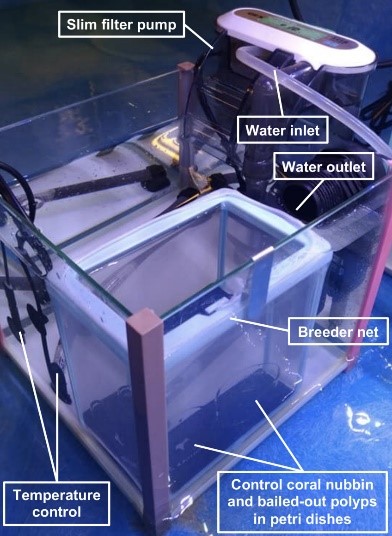
- Influence of regional oceanography and hydrothermal activity on protist diversity and community structure in the Okinawa Trough
Microbial eukaryotes (protists) contribute substantially to ecological functioning in marine ecosystems, but the relative importance of factors shaping protist diversity, such as environmental selection and dispersal, remains difficult to parse. Water masses of a back-arc basin with hydrothermal activity provide a unique opportunity for studying the effects of dispersal and environmental selection on protist communities. In this study, we used metabarcoding to characterize protist communities in the Okinawa Trough, a back-arc spreading basin containing at least twenty-five active hydrothermal vent fields. Water was sampled from four depths at fourteen stations spanning the length of the Okinawa Trough, including three sites influenced by nearby hydrothermal vent sites. While significant differences in community structure reflecting water depth were present, protist communities were mostly homogeneous horizontally. Protist communities in the bottom waters affected by hydrothermal activity were significantly different from communities in other bottom waters, suggesting that environmental factors can be especially important in shaping community composition under specific conditions. Amplicon sequence variants that were enriched in hydrothermally influenced bottom waters largely derived from cosmopolitan protists that were present, but rare, in other nearbottom samples, thus highlighting the importance of the rare biosphere.

- Extreme storms cause rapid but short‐lived shifts in nearshore subtropical bacterial communities.
Climate change scenarios predict tropical cyclones will increase in both frequency and intensity, which will escalate the amount of terrestrial run-off and mechanical disruption affecting coastal ecosystems. Bacteria are key contributors to ecosystem functioning, but relatively little is known about how they respond to extreme storm events, particularly in nearshore subtropical regions. In this study, we combine field observations and mesocosm experiments to assess bacterial community dynamics and changes in physicochemical properties during earlyand late-season tropical cyclones affecting Okinawa, Japan. Storms caused large and fast influxes of freshwater and terrestrial sediment – locally known as red soil pollution – and caused moderate increases of macronutrients. We detected shifts in relative abundances of marine and terrestrially derived bacteria, including putative coral and human pathogens, during storm events. Soil input alone did not substantially affect marine bacterial communities in mesocosms, indicating that other components of run-off or other storm effects likely exert a larger influence on bacterial communities. The storm effects were short-lived and bacterial communities quickly recovered following both storm events. The early- and late-season storms caused different physicochemical and bacterial community changes, demonstrating the context-dependency of extreme storm responses in a subtropical coastal ecosystem.

- Paired high-throughput, in situ imaging and high-throughput sequencing illuminate acantharian abundance and vertical distribution
Acantharians (supergroup Rhizaria) can be important contributors to surface primary production and to carbon flux to the deep sea, but are often underestimated because their delicate structures are destroyed by plankton nets or dissolved by chemical fixatives. As they are also uncultured, relatively little is known about acantharian biology, especially regarding their life cycles. Here, we take a paired approach, bringing together high-throughput, in situ imaging and metabarcode sequencing, to investigate acantharian abundance, vertical distribution, and life history in the western North Pacific. Concentrations of imaged acantharian cells correlated well with relative abundances of 18S rRNA gene sequences from acantharians with known, recognizable morphologies, but not to sequences corresponding to acantharians with unknown morphology. These results suggest that morphologically undescribed clades may lack the characteristic star-shaped acantharian skeleton or are much smaller than described acantharians. The smaller size of acantharians imaged at depth supports current hypotheses regarding nonsymbiotic acantharian life cycles: cysts or vegetative cells release reproductive swarmer cells in deep water and juvenile cells grow as they ascend toward the surface. Moreover, sequencing data present the possibility that some photosymbiotic acantharians may also reproduce at depth, like their nonsymbiotic, encysting relatives, which is counter to previous hypotheses. Finally, in situ imaging captured a new acantharian behavior that may be a previously undescribed predation strategy.
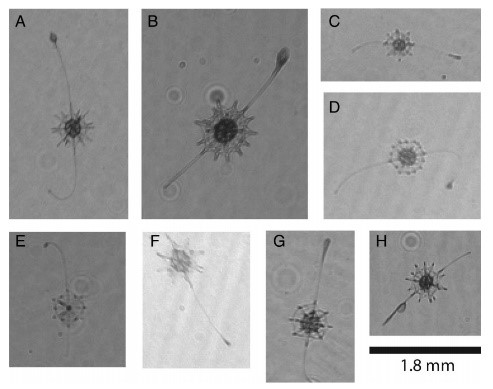
- Signaling pathways in the coral polyp bail-out response
Polyp bail-out is a stress response exhibited by some pocilloporid corals, with mechanisms and consequences distinct from those of bleaching. Although induction of polyp bail-out has been demonstrated in the laboratory, molecular mechanisms underlying this response have rarely been discussed. We conducted genetic analyses of Pocillopora acuta during initiation of hyperosmosisinduced polyp bail-out, using both transcriptomic and qPCR techniques. Beyond upregulation of apoptosis and proteolysis, corals showed significant activation of tumor necrosis factor and fibroblast growth factor (FGF) signaling pathways during induction of polyp bail-out. In our qPCR analysis, a common upregulation profile, peaking at 43.0% salinity, was found in the FAS and CASP8 genes, whereas a different profile, showing significant upregulation up to 45.0%, was displayed by matrix metalloproteinases and genes in the FGF signaling pathway. These results suggest parallel involvement of an extrinsic apoptotic signaling pathway and FGF-mediated extracellular matrix degradation in polyp bail-out. Furthermore, in the XIAP, JNK, and NFKB1 genes, we detected a third expression profile showing linear upregulation that becomes maximal at the endpoint salinity level of the experiment (46.0%), indicating activation of anti-apoptotic and cell survival signals during polyp bail-out. Our results provide new insights into signaling pathways responsible for polyp bail-out and suggest the feasibility of inducing bail-out by specifically triggering these pathways without exerting lethal stresses on the corals, which in turn will facilitate acquisition of viable polyps for possible use in coral reef restoration.
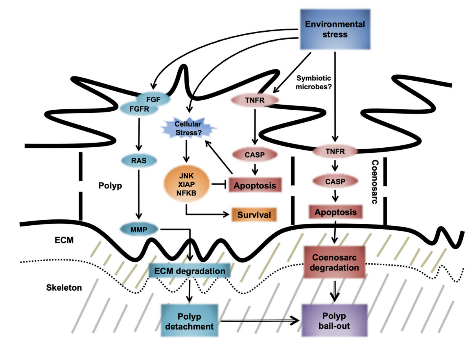
- Evolutionary biogeography of the reef-building coral genus Galaxea across the Indo-Pacific ocean
Stony corals (Scleractinia) form the basis for some of the most diverse ecosytems on Earth, but we have much to learn about their evolutionary history and systematic relationships. In order to improve our understanding of species in corals we here investigated phylogenetic relationships between morphologically defined species and genetic lineages in the genus Galaxea (Euphyllidae) using a combined phylogenomic and phylogeographic approach. Previous studies revealed the nominal species G. fascicularis included three genetically well-differentiated lineages (L, S & L+) in the western Pacific, but their distribution and relationship to other species in the genus was unknown. Based on genomic (RAD-seq) and mitochondrial sequence data (non-coding region between cytb and ND2) we investigated whether the morphological taxa represent genetically coherent entities and what is the phylogenetic relationship and spatial distribution of the three lineages of G. fascicularis throughout the observed species range. Using the RAD-seq data, we find that the genus Galaxea is monophyletic and contains three distinct clades: an Indo-Pacific, a Pacific, and a small clade restricted to the Chagos Archipelago. The three lineages of G. fascicularis were associated with different RAD-seq clades, with the ‘L’ lineage showing some morphological distinction from the other two lineages (larger more asymmetrical polyps). In addition to these, three more genetic lineages in G. fascicularis may be distinguished – a Chagossian, an Ogasawaran, and one from the Indian-Red Sea. Among nominal taxa for which we have multiple samples, G. horrescens was the only monophyletic species. The mitochondrial non-coding region is highly conserved apart of the length polymorphism used to define L, S & L+ lineages and lacks the power to distinguish morphological and genetic groups resolved with genomic RAD-sequencing. The polyphyletic nature of most species warrants a careful examination of the accepted taxonomy of this group with voucher collections and their comparison to type specimens to resolve species boundaries. Further insight to the speciation process in corals will require international cooperation for the sharing of specimens to facilitate scientific discovery.

- A persistent Kuroshio in the glacial East China Sea and implications for coral paleobiogeography
The Kuroshio Current is a major hydrographical feature of the modern East China Sea, but it has been suggested that its flow was diverted to the east of the Ryukyu Arc at the Last Glacial Maximum. Shoaling of the Yonaguni Depression has also been proposed as a cause of Kuroshio Current diversion which, while unlikely to have been significant at the Last Glacial Maximum, may have been an important consideration further back in time. Using an ensemble of high‐resolution ocean simulations with climatic boundary conditions emulating those of the Last Glacial Maximum, we present the first regional state estimates of the glacial East China Sea which are both physically consistent and compatible with sea surface temperature proxy compilations. We find that while the Kuroshio Current transport in the East China Sea is slightly reduced at the Last Glacial Maximum, its path is relatively unchanged, with limited sensitivity to glacioeustatic sea level change, glacial‐interglacial changes in climate, and tectonic shoaling of the Yonaguni Depression. Simulations with the best model‐proxy agreement predict only limited contraction of the reef front at the Last Glacial Maximum, and strong surface currents associated with the glacial Kuroshio may have maintained or even improved long‐distance coral larval dispersal along the Ryukyu Arc, suggesting that conditions may have enabled coral reefs in this region to remain widespread throughout the last glacial. Further field studies investigating whether this is genuinely the case will provide insights into how the coral reef front responds to long‐term environmental change.
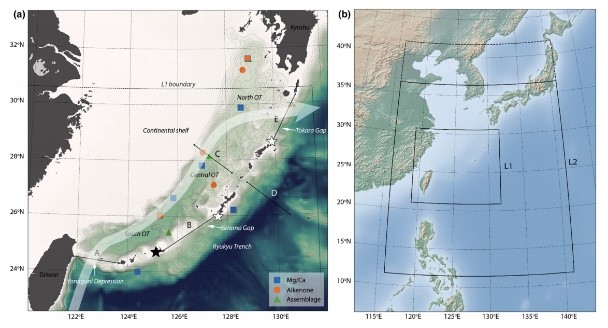
- Reef influence quantification in light of the 1771 Meiwa tsunami
While interactions between regular wave driven flooding and reefs have been widely studied due to climate change pressure, the effects of reefs on tsunami flooding have less been investigated. From studies of historical events, reefs can behave as buffers or as amplifiers of inundation, depending upon the location. Interactions between reefs and tsunamis have generally been analyzed with idealized models, and there have been only few studies of specific reefs and their characteristics. Using numerical NonLinear Shallow Water models, this study characterizes the influence of the Southeast Ishigaki Island reef during the 1771 tsunami that hit the Yaeyama Islands. In this work, we modified reef topography in silico and then, measured the impact of these changes using a new parameter, the Reef Impact Factor (RIF). First, a reference model was built, simulating the real event with an accurate reef representation and using run-up data to calibrate bottom friction. This calibration highlights the difficulty of representing reef friction with a homogeneous coefficient. Second, a model without a reef was compared to the reference model. The impact of reef removal varies considerably along the coastline and maximum wave heights at the shore were strongly affected, with a 12:5% increase on average. Overall, this suggests a protective role of the reef along most of the coast. However, at local scale, channels that break the continuity of the front reef, increased wave heights by up to 40% on the proximate coast, revealing their strong focusing influence. Finally, changes in tide level, which regulates reef depth, were investigated, showing a global positive correlation between sea level and maximum wave height at the coast. However, the impact of the reef depth appeared weak compared to the impact of incident wave parameters. This study contributes to a global effort to understand tsunami-reef interactions in a non-idealized framework, suggesting a Reef Impact Factor for inter-reef/study comparisons. Moreover, vulnerable and exposed coasts were identified at Ishigaki Island, which may help to improve inundation forecasting, resulting in more appropriate management of these vulnerable sections of the coast.
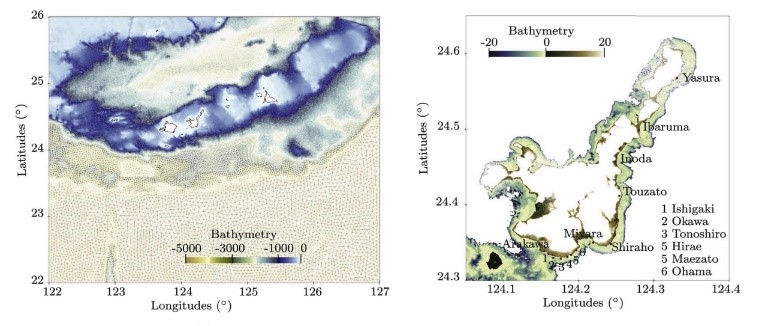
4. Publications
4.1 Journals
- N. Takeda, M. Kashima, S. Odani, Y. Uchiyama, Y. Kamidaira, S. Mitarai, Identification of coral spawn source areas around Sekisei Lagoon for recovery and poleward habitat migration by using a particle-tracking model. Sci. Rep. 11, 6963 (2021).
- P.-S. Chuang, K. Ishikawa, S. Mitarai, Morphological and genetic recovery of coral polyps after bail-out. Front. Mar. Sci. 8 (2021).
- M. Mars Brisbin, A. E. Conover, S. Mitarai, Influence of Regional Oceanography and Hydrothermal Activity on Protist Diversity and Community Structure in the Okinawa Trough. Microb. Ecol. (2020).
- Á. Ares, M. M. Brisbin, K. N. Sato, J. P. Martín, Y. Iinuma, S. Mitarai, Extreme storms cause rapid but short‐lived shifts in nearshore subtropical bacterial communities. Environ. Microbiol. 2, 541 (2020).
- M. Mars Brisbin, O. D. Brunner, M. M. Grossmann, S. Mitarai, Paired high-throughput, in situ imaging and high-throughput sequencing illuminate acantharian abundance and vertical distribution. Limnol. Oceanogr. (2020).
- P.-S. Chuang, S. Mitarai, Signaling pathways in the coral polyp bail-out response. Coral Reefs (2020).
- P. H. Wepfer, Y. Nakajima, M. Sutthacheep, V. Z. Radice, Z. Richards, P. Ang, T. Terraneo, M. Sudek, A. Fujimura, R. J. Toonen, A. S. Mikheyev, E. P. Economo, S. Mitarai, Evolutionary biogeography of the reef-building coral genus Galaxea across the Indo-Pacific ocean. Mol. Phylogenet. Evol. 151, 106905 (2020).
- L. A. Levin, C.-L. Wei, D. C. Dunn, D. J. Amon, O. S. Ashford, W. W. L. Cheung, A. Colaço, C. Dominguez-Carrió, E. G. Escobar, H. R. Harden-Davies, J. C. Drazen, K. Ismail, D. O. B. Jones, D. E. Johnson, J. T. Le, F. Lejzerowicz, S. Mitarai, T. Morato, S. Mulsow, P. V. R. Snelgrove, A. K. Sweetman, M. Yasuhara, Climate change considerations are fundamental to management of deep-sea resource extraction. Glob. Chang. Biol. (2020).
- N. S. Vogt‐Vincent, S. Mitarai, A Persistent Kuroshio in the Glacial East China Sea and Implications for Coral Paleobiogeography. Paleoceanography and Paleoclimatology. 35, 897 (2020).
- M. Le Gal, S. Mitarai, Reef influence quantification in light of the 1771 Meiwa tsunami. Ocean Coast. Manag. 195, 105248 (2020).
4.2 Books and other one-time publications
Nothing to report
4.3 Oral and Poster Presentations (only those an MBU member presented)
- M. M. Brisbin, Characterization of Acantharea-Phaeocystis photosymbioses: distribution, abundance, specificity, maintenance and host-control, Ph.D. Thesis Presentation, OIST, Online, 17 April 2020.
- O. Brunner, S. Mitarai, V. Tunnicliffe, Hydrothermal vent community assemblage networks of the North-West Pacific, eDSBS, Deep Sea Biology Society, Online, 20-21 August 2020.
- M. M. Brisbin, Maintenance & manipulation of algal endosymbionts in a unicellular host (Acantharea), Online Weekly International Symbiosis Seminar, Organized by Prof. Greg Hurst (Liverpool) and Nicole Gerardo (Emory University), Online, 5 May 2020.
- M. M. Brisbin, Morpho-genetic manipulation of algal symbionts in an abundant planktonic photosymbiosis, International Advisory Board Meeting for OIST Marine Science, OIST, Online, 8 October 2020.
- Y. Yamada, Bacteria and viruses regulate carbon cycle in the ocean, 2020 Online Annual Meeting, Geochemical Society of Japan, Online, 21 November 2020
- Y. Yamada, N. Patel, F. Azam, S. Mitarai, The effect of bacterial surface properties on nano-sized particle attachments to bacteria in seawater, JOS Fall Meeting, Oceanographic Society of Japan, Online, 29 November 2020
- Y. Yamada, T. Yokokawa, M. Shigemitsu, Session 20F-05 Microbial activities related to material cycles in the ocean-from cellular scale to oceanic scale, JOS Fall Meeting, Oceanographic Society of Japan, Online, 29 November 2020
- Y. Nakajima, S. Suzuki, S. Mitarai, Time-series fluctuation of genotypes in symbiotic zooxanthellae during cold bleaching and recovery of Acropora corals, 23rd JCRS Meeting, Japanese Coral Reef Society, Online, 21-23 November 2020.
5. Intellectual Property Rights and Other Specific Achievements
Nothing to report
6. Meetings and Events
- Invited lecture: none
- Workshop: none
- Mini-symposium
Title: Seeing is Believing: integrating next-gen sequencing with high-throughput & high-resolution imaging in marine microbial ecology
Dates : Cancelled due to COVID-19 (Originally scheduled on September 23–25, 2020)
7. Other
7.1 Grants (Currenly Funded)
- JSPS Grant-in-Aid for Early-Career Scientist
Title: Biomonitoring of Red Soil Pollution by DNA-based methods in Okinawa
PI name: Angela Ares
Grant Number: 20K19986
Dates of Award: April 1, 2020 to March 31, 2023
Budget Amount: ¥3,380,000 (Direct Cost: ¥2,600,000、Indirect Cost: ¥780,000)
- JSPS Grant-in-Aid for Early-Career Scientist
Title: Investigation of the effect of bacterial surface roughness on nanoparticle attachments in seawater
PI name: Yosuke Yamada
Grant Number: 20K19960
Dates of Award: April 1, 2020 to March 31, 2023
Budget Amount: ¥4,160,000 (Direct Cost: ¥3,200,000、Indirect Cost: ¥960,000)
- JSPS Grant-in-Aid for JSPS Fellows
Title: Investigation of coral emergent property from polyp to colony
PI name: Po-Shun Chuang
Grant Number: 18J20226
Dates of Award: April 1, 2018 to March 31, 2021
Budget Amount: ¥2,800,000 (Direct Cost: ¥2,800,000)
- The University of Tokyo, Atmosphere and Ocean Research Institute Interdisciplinary Collaborative Research
Title: Investigation of the effects of environmental parameters on the bacterial surface roughness in seawater
PI name: Yosuke Yamada
Dates of Award: April 1, 2020 to March 31, 2021
Budget Amount: ¥700,000
7.2 Grants (Recently Awarded)
- Sasakawa Scientific Research Grant, The Japan Science Society
Title: Development of the quantitative analysis method of particle aggregation in seawater
PI name: Yosuke Yamada
Grant Number:2021-6014
Dates of Award: April 1, 2021-February 28, 2022
Budget Amount: ¥960,000
- Fusion Oriented Research for disruptive Science and Technology (FOREST) program
Title: Investigation of bacterial surface characteristics and carbon acquisition mechanisms in seawater
PI name: Yosuke Yamada
Dates of Award: April 1, 2021-March 31, 2024
Budget Amount: Not decided (ca. 20 million yen)



